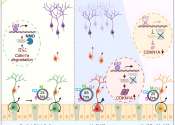Inherited traits can be overstated, study shows
Behavioral similarities between parents and their offspring are less marked than is often suggested, a new study shows.
1 hour ago
0
0
Behavioral similarities between parents and their offspring are less marked than is often suggested, a new study shows.
1 hour ago
0
0

By analyzing samples of flour and rice stored in homes in Ribeirão Preto, in the interior of the state of São Paulo (Brazil), researchers from the University of São Paulo (USP) found the presence of high levels of fungal ...
4 hours ago
0
0

For most patients, it's unknown exactly what causes amyotrophic lateral sclerosis (ALS), a disease characterized by degeneration of motor neurons that impairs muscle control and eventually leads to death.
6 hours ago
0
1

Patients in remission after battling a high-risk blood cancer are likely to have better outcomes if no trace of the cancer is detectable before the patients receive donor blood cells.
6 hours ago
0
48

The locus coeruleus (LC) is a small region of the brainstem that produces norepinephrine, a chemical with powerful effects on arousal and wakefulness which plays an important role in the body's response to stress or panic. ...
6 hours ago
0
12

The length of telomeres in white blood cells, known as leukocytes, varies significantly among sub-Saharan African populations, researchers report in The American Journal of Human Genetics. Moreover, leukocyte telomere length ...
6 hours ago
0
5

Genetics can be associated with one's behavior and health—from the willingness to take risks, and how long one stays in school, to chances of developing Alzheimer's disease and breast cancer. Although our fate is surely ...
6 hours ago
0
6

Researchers analyzing the DNA of people with kidney cancer worldwide have found evidence of an unknown trigger that could explain the longstanding mystery of why some countries have a higher incidence of the disease.
7 hours ago
0
1

Nonsense-mediated RNA decay, or NMD, is an evolutionarily conserved molecular mechanism in which potentially defective messenger RNAs, or mRNAs (genetic material that instructs the body on how to make proteins), are degraded. ...
May 1, 2024
0
38

Researchers say a machine learning tool can identify many patients with rare, undiagnosed diseases years earlier than current methods, potentially improving outcomes and reducing cost and morbidity. The findings, led by researchers ...
May 1, 2024
0
44

Genetics (from Ancient Greek γενετικός genetikos, “genitive” and that from γένεσις genesis, “origin”), a discipline of biology, is the science of heredity and variation in living organisms. The fact that living things inherit traits from their parents has been used since prehistoric times to improve crop plants and animals through selective breeding. However, the modern science of genetics, which seeks to understand the process of inheritance, only began with the work of Gregor Mendel in the mid-nineteenth century. Although he did not know the physical basis for heredity, Mendel observed that organisms inherit traits via discrete units of inheritance, which are now called genes.
Genes correspond to regions within DNA, a molecule composed of a chain of four different types of nucleotides—the sequence of these nucleotides is the genetic information organisms inherit. DNA naturally occurs in a double stranded form, with nucleotides on each strand complementary to each other. Each strand can act as a template for creating a new partner strand—this is the physical method for making copies of genes that can be inherited.
The sequence of nucleotides in a gene is translated by cells to produce a chain of amino acids, creating proteins—the order of amino acids in a protein corresponds to the order of nucleotides in the gene. This relationship between nucleotide sequence and amino acid sequence is known as the genetic code. The amino acids in a protein determine how it folds into a three-dimensional shape; this structure is, in turn, responsible for the protein's function. Proteins carry out almost all the functions needed for cells to live. A change to the DNA in a gene can change a protein's amino acids, changing its shape and function: this can have a dramatic effect in the cell and on the organism as a whole. Two additional factors that can change the shape of the protein are pH and temperature.
Although genetics plays a large role in the appearance and behavior of organisms, it is the combination of genetics with what an organism experiences that determines the ultimate outcome. For example, while genes play a role in determining an organism's size, the nutrition and other conditions it experiences after inception also have a large effect.
This text uses material from Wikipedia, licensed under CC BY-SA